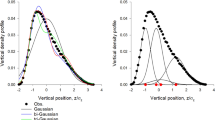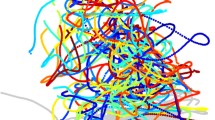Abstract
In a theoretical simulation the cooperation of two insects is investigated who share a large number of maximally entangled EPR-pairs to correlate their probabilistic actions. Specifically, two distant butterflies must find each other. Each butterfly moves in a chaotic form of short flights, guided only by the weak scent emanating from the other butterfly. The flight directions result from classical random choices. Each such decision of an individual is followed by a read-out of an internal quantum measurement on a spin, the result of which decides whether the individual shall do a short flight or wait. These assumptions reflect the scarce environmental information and the small brains’ limited computational capacity. The quantum model is contrasted to two other cases: In the classical case the coherence between the spin pairs gets lost and the two butterflies act independently. In the super classical case the two butterflies read off their decisions of whether to fly or to wait from the same internal list so that they always take the same decision as if they were super correlated. The numerical simulation reveals that the quantum entangled butterflies find each other with a much shorter total flight path than in both classical models.


Similar content being viewed by others
References
Bandyopadhyay S, Lidar DA (2004) arXiv: quant-ph/0408174
Brassard G, Broadbent A, Tapp A (2004) arXiv: quant-ph/0407221
Brukner C, Paunkovic N, Rudolph T, Vedral V (2006) Entanglement-assisted orientation in space. Int J Quantum Inf (IJQI) 4:365–370
Dawson CM, Hines AP, McKenzie RH, Milburn GJ (2004) arXiv: quant-ph/0407206
Hagan S, Hameroff SR, Tuszynski JA (2002) Quantum computation in brain microtubules: decoherence and biological feasibility. Phys Rev E 65:061901
Hameroff SR, Penrose R (1996) Orchestrated reduction of quantum coherence in brain microtubules. In: Hameroff S, Kasszniak AK, Scott AC (eds) Toward a science of consciousness. MIT Press, Cambridge
Josephson BD, Pallikari-Viras F (1991) Biological utilisation of quantum non-locality. Found Phys 21:197–207
Julsgaard B, Kozhekin A, Polzik ES (2001) Experimental long-lived entanglement of two macroscopic objects. Nat Biotechnol 413:400
Kaszlikowski D, Gnacinski P, Zukowski M, Miklaszewski W, Zeilinger A (2000) arXiv: quant-ph/0005028
Klimovitch GV (2004) arXiv: quant-ph/0405093
Mermin ND (1990) Extreme quantum entanglement in a superposition of macroscopically distinct states. Phys Rev Lett 65:1838
Pan J-W, Bouwmeester D, Weinfurter H, Zeilinger A (1998) Experimental entanglement swapping: entangling photons that never interacted. Phys Rev Lett 80:3891
Phoenix SJD, Barnett SM (1993) Non-local interatomic correlations in the micromaser. J Mod Opt 40:979
Summhammer J (2005) arXiv: quant-ph/0503136v2
Svozil K (2004) arXiv: quant-ph/0411190
Tessieri L, Wilkie J (2003) Decoherence in a spin-spin-bath model with environmental self-interaction. J Phys A 36:12305
Toner BF, Bacon D (2003) Communication cost of simulating bell correlations. Phys Rev Lett 91:187904
Wu L-A, Lidar DA, Schneider S (2004) arXiv: quant-ph/0402209
Zhang J, Vala J, Sastry S, Whaley KB (2003) Geometric theory of non local two-qubit operations. Phys Rev A 67:042313
Acknowledgments
I am indebted to the organizers of this conference for having invited me to present these ideas.
Author information
Authors and Affiliations
Corresponding author
Rights and permissions
About this article
Cite this article
Summhammer, J. Quantum Cooperation. Axiomathes 21, 347–356 (2011). https://doi.org/10.1007/s10516-010-9139-3
Received:
Accepted:
Published:
Issue Date:
DOI: https://doi.org/10.1007/s10516-010-9139-3




